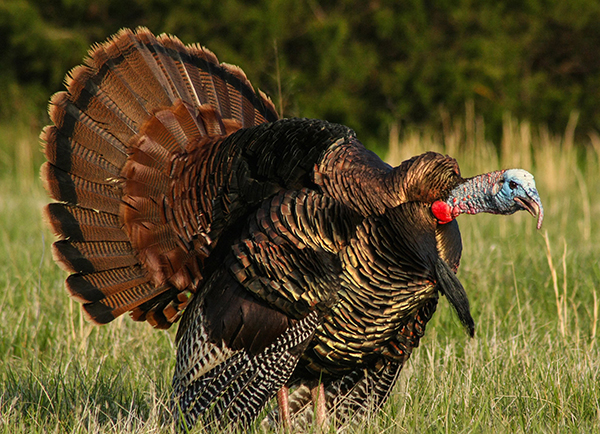There are two compelling storylines leading up to Kentucky’s 2023 spring wild turkey season.
What impact, if any, will the unseasonably warm late winter have on wild turkey behavior and breeding during the spring hunting season, and why has the hunter harvest during the spring season dropped from its 10-year and all-time highs?
These are complex questions with no clear-cut answers.

Kentucky’s 23-day statewide general spring wild turkey season opens Saturday, April 15 (Photo from National Wild Turkey Federation)
Warm weather in late winter makes turkeys more active earlier, but photoperiod — or length of daylight — is what triggers breeding.
Unseasonably warm weather makes many turkey hunters anxious to be in the woods, and begs the question: why doesn’t our spring season start earlier in the year?
Opening day of Kentucky’s 23-day spring season is by regulation on the Saturday closest to April 15.
There are solid, time-tested reasons for our season’s timeframe. It’s a conservative approach adopted decades ago to give turkeys time to fully engage in their spring breeding ritual. The season is set so that the majority of hens are bred before the hunting starts. As they leave the company of gobblers to go on the nest, the gobbling picks back up. This is the so-called second peak of gobbling.
This timeframe protects hens from unintentional harvest and ensures that gobblers have bred most of the hens while providing good hunting opportunities since gobblers are vocal and actively seeking hens that have not gone on the nest. Gobblers without hens are much easier to call into gun range.

The second storyline is also decades in the making, and more localized, as flock sizes vary over time, influenced by breeding success, the quality and abundance of nesting and brood-rearing habitat, hunting pressure and predator (coyote) densities.
Hunter participation and weather also factors into how many turkeys are taken by hunters. Poor hunting conditions — prolonged periods of rain, cold, thunderstorms and other inclement weather conditions — mean fewer hunters afield.
2022 Spring Season Harvest
The 2022 spring harvest was 26,862 bearded turkeys, 2,359 less than the 2021 spring season.
In five of the 10 spring seasons since 2013, hunters bagged less than 30,000 birds. The spring harvest is trending is a range from a high of 33,072 in 2017 to last season’s low of 26,862.
Last spring’s harvest was not influenced by poor weather, as temperatures were seasonable with little rain and light winds.
The top five counties in turkey harvest for the 2022 spring season were: Logan, 537; Muhlenberg, 525; Graves, 506; Ohio, 476, and Hart, 462.
There were 10 counties where hunters took more than 410 turkeys. The top two Wildlife Division Regions in turkey harvest during the spring season were: Green River Region (25 counties) 7,716, and Bluegrass Region (31 counties) 5,968.
Possible Reasons for Declines in Turkey Populations
The long-term decline in turkey populations and a correspondingly lower hunter harvest is not just happening in Kentucky. Many states in the eastern U.S. are experiencing a similar situation.
Biologists in the region agree that some of the causes locally could include: lower poult production, nesting and brood-rearing habitat is not as good as it once was, carrying capacity has been reached, former pastures have been converted to grain production, and timber cutting has declined.
Although it appears that acres in small grains, such as wheat and corn have noticeably increased in many areas of Kentucky in recent years, the statewide statistics don’t really indicate any major land use changes.
For example, the USDA statewide numbers for Kentucky compiled by the National Ag Statistics Service show that the 15-year average for wheat is 520,000 acres. Last year the acreage in wheat was 530,000. The trend is similar for corn, and doesn’t indicate a dramatic land-use shift of acres in production in recent years.
In fact, there’s a good argument that farmers are producing more bushels of grains on the same acreages due to advances in technology.
Wild Turkey Restoration in Kentucky
Most of the wild turkey restoration work, stocking birds across the state, took place in a 20 year period beginning in 1975. By the late 1980s, wild turkey flocks began to grow rapidly.
Kentucky’s restoration program ended in 1997. At that time the state’s wild turkey population had grown to an estimated 130,000 birds.
For the 10-year period from 2000 to 2009, the wild turkey harvest in Kentucky increased by 59 percent, from a low of 18,243 to a high of 29,008.
The 2010 spring season yielded a record harvest of 36,094 that stands to this day. In 2010 Kentucky’s wild turkey flock was estimated to number 220,000, and the state had about 90,000 wild turkey hunters.
The record kill was encouraged by record reproduction in 2008, with the brood survey showing an average of 3.7 poults per hen (PPH) statewide, one of the highest numbers ever observed in Kentucky. By comparison, the 2022 brood survey reported an estimated 2.3 PPH statewide.
Zak Danks, Kentucky’s wild turkey program coordinator said he can’t over emphasize the importance of the turkey hatch to hunter success.
Since a majority of adult turkeys taken by hunters during the spring season are two year-olds, an increase or decrease in reproductive success for a given year is typically reflected in the hunter harvest two years later.
2023 Spring Turkey Season Dates
Kentucky’s 23-day statewide general season opens Saturday, April 15, and continues through Sunday, May 7.
The two-day youth weekend, by regulation held on the first weekend in April, opens April 1 and closes Sunday, April 2, 30 minutes after sunset.
Hunters may take two bearded turkeys during the spring season. Danks has said in the past that a reduction in the bag limit would only be considered if there were several years in a row of steep declines in the harvest during the spring season.
Think spring turkeys!
Don’t miss out on witnessing the wild turkey’s passion play, a spring mating ritual that is unsurpassed in drama and suspense.
























